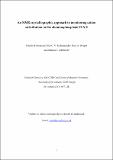Files in this item
An NMR crystallographic approach to monitoring cation substitution in the aluminophosphate STA-2
Item metadata
| dc.contributor.author | Seymour, Valerie Ruth | |
| dc.contributor.author | Eschenroeder, Eike Christian Viktor | |
| dc.contributor.author | Wright, Paul Anthony | |
| dc.contributor.author | Ashbrook, Sharon Elizabeth | |
| dc.date.accessioned | 2016-05-03T23:32:19Z | |
| dc.date.available | 2016-05-03T23:32:19Z | |
| dc.date.issued | 2014 | |
| dc.identifier | 157393332 | |
| dc.identifier | 74413431-0cd0-42f5-a40e-fe2023990efa | |
| dc.identifier | 84924616254 | |
| dc.identifier | 000350874400008 | |
| dc.identifier | 25465483 | |
| dc.identifier.citation | Seymour , V R , Eschenroeder , E C V , Wright , P A & Ashbrook , S E 2014 , ' An NMR crystallographic approach to monitoring cation substitution in the aluminophosphate STA-2 ' , Solid State Nuclear Magnetic Resonance . https://doi.org/10.1016/j.ssnmr.2014.10.007 | en |
| dc.identifier.issn | 0926-2040 | |
| dc.identifier.other | ORCID: /0000-0002-4538-6782/work/56638949 | |
| dc.identifier.other | ORCID: /0000-0002-4243-9957/work/62668281 | |
| dc.identifier.uri | https://hdl.handle.net/10023/8720 | |
| dc.description | The authors thank the Leverhulme Trust (F/00 268/BJ), EPSRC (EP/E041825/1, EP/J501542/1, and EP/F018096/1) and the European Commission FP6 Marie Curie Research Training Network “INDENS” (MRTN-CT-2004–005503), and the Leverhulme Trust (F/00 268/BJ) for support. Accepted 23rd October 2014. | en |
| dc.description.abstract | The substitution of the divalent cations Mg2+ and Zn2+ into the aluminophosphate (AlPO) framework of STA-2 has been studied using an “NMR crystallographic” approach, combining multinuclear solid-state NMR spectroscopy, X-ray diffraction and first-principles calculations. Although the AlPO framework itself is inherently neutral, the positive charge of the organocation template in an as-made material is usually balanced either by the coordination to the framework of anions from the synthesis solution, such as OH− or F−, and/or by the substitution of aliovalent cations. However, the exact position and distribution of the substituted cations can be difficult to determine, but can have a significant impact upon the catalytic properties a material exhibits once calcined. For as-made Mg substituted STA-2, the positive charge of the organocation template is balanced by the substitution of Mg2+ for Al3+ and, where required, by hydroxide anions coordinated to the framework. [27] Al MAS NMR spectra show that Al is present in both tetrahedral and five-fold coordination, with the latter dependent on the amount of substituted cations, and confirms the bridging nature of the hydroxyl groups, while high-resolution MQMAS spectra are able to show that Mg appears to preferentially substitute on the Al1 site. This conclusion is also supported by first-principles calculations. The calculations also show that 31P chemical shifts depend not only on the topologically-distinct site in the SAT framework, but also on the number of next-nearest-neighbour Mg species, and the exact nature of the coordinated hydroxyls (whether the P atom forms part of a six-membered ring, P(OAl)2OH, where OH bridges between two Al atoms). The calculations demonstrate a strong correlation between the 31P isotropic chemical shift and the average bond angle. In contrast, for Zn substituted STA-2, both X-ray diffraction and NMR spectroscopy show less preference for substitution onto Al1 or Al2, with both appearing to be present, although that into Al1 appears slightly more favoured. | |
| dc.format.extent | 11 | |
| dc.format.extent | 829203 | |
| dc.language.iso | eng | |
| dc.relation.ispartof | Solid State Nuclear Magnetic Resonance | en |
| dc.subject | QD Chemistry | en |
| dc.subject.lcc | QD | en |
| dc.title | An NMR crystallographic approach to monitoring cation substitution in the aluminophosphate STA-2 | en |
| dc.type | Journal article | en |
| dc.contributor.sponsor | EPSRC | en |
| dc.contributor.sponsor | The Leverhulme Trust | en |
| dc.contributor.sponsor | European Commission | en |
| dc.contributor.sponsor | EPSRC | en |
| dc.contributor.sponsor | EPSRC | en |
| dc.contributor.sponsor | EPSRC | en |
| dc.contributor.institution | University of St Andrews. School of Chemistry | en |
| dc.contributor.institution | University of St Andrews. EaSTCHEM | en |
| dc.identifier.doi | https://doi.org/10.1016/j.ssnmr.2014.10.007 | |
| dc.description.status | Peer reviewed | en |
| dc.date.embargoedUntil | 2016-05-04 | |
| dc.identifier.url | http://www.sciencedirect.com/science/article/pii/S0926204014000617#appd002 | en |
| dc.identifier.grantnumber | EP/E041825/1 | en |
| dc.identifier.grantnumber | F/00 268/BJ | en |
| dc.identifier.grantnumber | MRTN-CT-2004-005503-INDENS-P WRIGHT | en |
| dc.identifier.grantnumber | EP/J501542/1 | en |
| dc.identifier.grantnumber | EP/F018096/1 | en |
| dc.identifier.grantnumber | EP/J501542/1 | en |
This item appears in the following Collection(s)
Items in the St Andrews Research Repository are protected by copyright, with all rights reserved, unless otherwise indicated.

